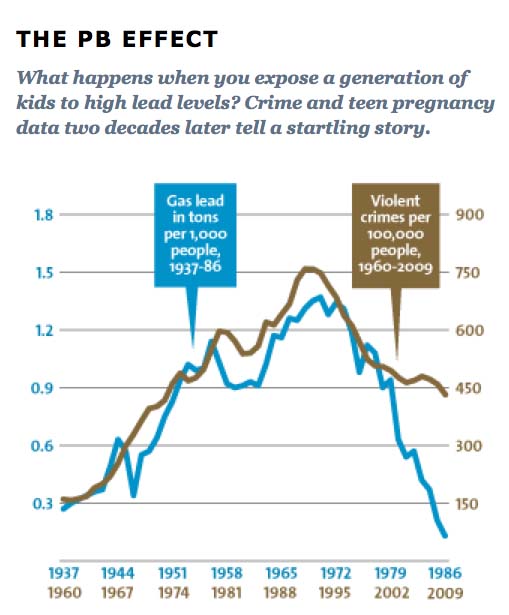Was Lead Contamination the Major Cause of 20th Century American Crime?
 That's the hypothesis that Kevin Drum makes in the latest issue of Mother Jones, and he has a lot of evidence to back it up.
That's the hypothesis that Kevin Drum makes in the latest issue of Mother Jones, and he has a lot of evidence to back it up.
For years, scientists have known about the link between lead exposure in children and decreasing IQ levels. More recently, researchers have discovered more subtle effects in terms of anti-social behavior and AHHD diagnosis. Now, modern toxicology is to the point where most leading researchers say there is no level of lead a child can be exposed to that doesn't have the potential to effect his or her personality.
What if you were to use what we know now about the effects of lead contamination on young minds and playback the last 70 years of American history?
The biggest source of lead in the postwar era, it turns out, wasn't paint. It was leaded gasoline. And if you chart the rise and fall of atmospheric lead caused by the rise and fall of leaded gasoline consumption, you get a pretty simple upside-down U: Lead emissions from tailpipes rose steadily from the early '40s through the early '70s, nearly quadrupling over that period. Then, as unleaded gasoline began to replace leaded gasoline, emissions plummeted.
Gasoline lead may explain as much as 90 percent of the rise and fall of violent crime over the past half century.Intriguingly, violent crime rates followed the same upside-down U pattern. The only thing different was the time period: Crime rates rose dramatically in the '60s through the '80s, and then began dropping steadily starting in the early '90s. The two curves looked eerily identical, but were offset by about 20 years.
So Nevin dove in further, digging up detailed data on lead emissions and crime rates to see if the similarity of the curves was as good as it seemed. It turned out to be even better: In a 2000 paper (PDF) he concluded that if you add a lag time of 23 years, lead emissions from automobiles explain 90 percent of the variation in violent crime in America. Toddlers who ingested high levels of lead in the '40s and '50s really were more likely to become violent criminals in the '60s, '70s, and '80s.
Dr. Howard Mielke of Tulane, who's analyzed the blood lead data collected from Frisco and found the samples higher than the state average, makes an appearance in Drum's article because of a large new study overlaying neighborhood lead exposure to neighborhood crime in six American cities. They match up precisely.
Read the short version of the article here. Here's an interview with Dr. Mielke.
No one knew a lead additive in gasoline would produce such an impact. Because we didn't do the toxicology. Lead was introduced in gasoline in the 1920's when the modern industrial age was just hitting its stride. Now there are some 80,000 chemicals in the marketplace, only a handful of which have been tested thoroughly, including lead, because we're still not doing the toxicology BEFORE the chemical is used in widespread commerce.
Cancer. Birth Defects. Endocrine Disruptors. Why is it so inconceivable to some that the thousands of untested chemicals coursing through the veins of our economy can't have unintended consequences just like leaded gasoline, on their own or in combination with each other? What new epidemics are we instigating even now?
